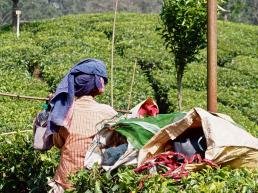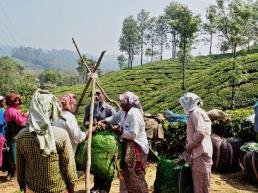As a tea lover, it’s always been a dream of mine to go see where it comes from. What better place than Munnar to explore its origins. A place where tea plantations sprawl, as far and as wide as the eyes can see.

It’s 4am on a cold, December Bangalore morning. I’ve just been woken by my alarm. Grumpy and groggy, I’ve dragged myself out of bed to get ready for what’s going to be a long day of driving. Nine hours to be precise. Good thing is, I have a Renault Duster to give me company. Better still, I’m sure I have a cup of freshly brewed tea waiting for me on the other side.
That’s because, we’re heading to Munnar. Located at about 1600m above sea level, Munnar is a haven for tea lovers. Thousands of tonnes of tea are grown in Munnar every year. Most of this is exported, only a fraction finding its way to a store near you. More on that later.

Munnar is 500km from Bangalore, my base location for this trip. I have with me a Renault Duster 4×4 for the entire journey. Powered by a 1.5L diesel, the Duster makes 108BHP and is coupled to a 6-speed manual gearbox. I’ve only briefly driven the Duster previously, but was left impressed by how supple its ride was. It seemed to fly over pot holes like none existed. That was one of the big reasons I chose to take the car on this trip. I wanted to experience how the addition of a 4-wheel drive system has changed the car.
The journey from Bangalore to Munnar can be taken via 2 routes. One via Salem and Dindigul, the other via Tiruppur. While the Tiruppur route is shorter, the one via Salem has less traffic. Both take about the same amount of time, but the one via Dindigul has some amazing, twisty mountain roads once you’re past Theni.

The journey from Bangalore to Munnar can be taken via 2 routes. One via Salem and Dindigul, the other via Tiruppur. While the Tiruppur route is shorter, the one via Salem has less traffic. Both take about the same amount of time, but the one via Dindigul has some amazing, twisty mountain roads once you’re past Theni.
The journey to Munnar took about 10 hours including stops. The last two and a half hours were spent navigating some of the best mountain roads I’ve seen in the country. Well paved and coupled with some spectacular views. The roads also allowed me to test the nimbleness of the Duster. Well, for a car that weighs nearly 1800kg’s, the Duster performed surprisingly well. I think part of that has to do with the fact that it hides its bulk so well. You never get this feeling you’re driving a big car. The proportions are just right, visibility is spot on and the car seems to shrink around you. Handling is decent too. It’s no sports car, but it offers ample fun and great traction courtesy of that 4×4 layout.

After a 10 hour drive to Munnar, I spent the rest of the day relaxing and soaking in the different shades of green. I cannot emphasise how beautiful the different shades of green you see in Munnar are. The light, deep green of the tea plantations mixes with the dark green of the dense forests to showcase a scene that’s utterly pleasing to the eyes, and the scene stretches out into the distance – mile after mile.
This entire experience was particularly put into focus when we decided to take a trek through a tea plantation the next day. The trek lasted about 8 hours, and I found it difficult to stow my camera away for the duration of the trek, for every bend revealed a new side of the mountain which was just as, if not more, photogenic than the previous one.

I also happened to chance upon a group of plantation workers weighing their harvest for the day. A conversation with one of them revealed that they work about 8 hours in a day. The day starts early, at about 7am. The first half ends at about 11am. They disperse for lunch and then get together at about 12:30pm to work for another 4 hours. Tea plantations and tourism, the two ways in which people in this area earn a livelihood.
These men and women had devised a clever way of measuring the weight of their their harvest. A tripod like arrangement made by tying together three loose wooden poles, with a weight gauge attached to one of the poles. Indian “jugaad” in action here.
Tired from the trek, I came back to the hotel and slept for the night. A satisfying 8 hour sleep later, I woke up to the sound of rain. Small water droplets sliding down the window pane. Rain had chosen the perfect day to present itself, for I was going to spend most of my time indoors that day – at the Lockhart tea factory. The factory is located within the Lockhart tea estate, around 10km away from the main town of Munnar.
The factory is owned by Harrisons Malayalam. Agglomerated the last 50 years, through acquisitions of smaller companies and individual estates, Harrisons Malayalam is one of the largest tea manufacturers in the country. Today, the company produces upwards of 20 million kg’s of tea every year in 6000 hectares of area spread across 12 estates and 10 states. In this particular factory, the company uses the orthodox tea manufacturing process.

The orthodox tea production process is more focused on preserving the authentic virtues of the leaf, while the CTC process is more focussed on mass production of consistent tasting tea. Orthodox teas are, as a result, inherently healthier than CTC teas. They also hold on to what is considered the authentic taste of tea a lot better as compared to CTC teas. CTC teas however, are better suited to additions like milk and lemon which we’re used to consuming with our teas.

The Lockhart tea factory allows visitors to see the entire manufacturing process. They also allow visitors to take a walk within their tea estate. I chose to drive around the estate – a task that involved testing the Duster’s 4×4 system. The rain had played havoc with the mud roads, turning them into a swamp of sorts. But the Duster dealt with them like very few other cars in that segment can – utterly smoothly. The one time it did get stuck, the Duster had an ace up its sleeve – a locking differential. A system that provides power to all 4 wheels simultaneously. A flick of the diff switch is all it took to take it out of a sticky situation.
If you’re in Munnar, I’d definitely recommend that you come visit the Lockhart tea factory. It’s a beautiful experience. I’d also recommend taking a walk through the estate, if the weather permits. The hues of green spreading across the land are stunning.

That evening, I returned to the hotel via a backroad that took me through a part of Munnar that is hidden from view by a range of hills. That drive would’ve been impossible if not for the Duster 4×4. Declaring the roads to be patchy would be an understatement, but the Duster 4×4 again handled the terrain with ease – gliding over even large potholes.

The following day, I returned to Bangalore – a satisfying trip coming to an end. A few days later, I realised what an important part the Duster 4×4 had played during the trip. You see, a 4×4 is largely useless in the city. it doesn’t offer much more than what a 4×2 does in an urban setting. But when you go out into the wild, a 4×4 makes so much sense. It puts into reach experiences and stories that would otherwise not be possible to explore. In that sense, the Duster 4×4 did a fabulous job. It was comfortable, capable off-road, gobbled up mile after mile effortlessly and never put a foot wrong. Just what you need from a car on a 1500km road trip.




